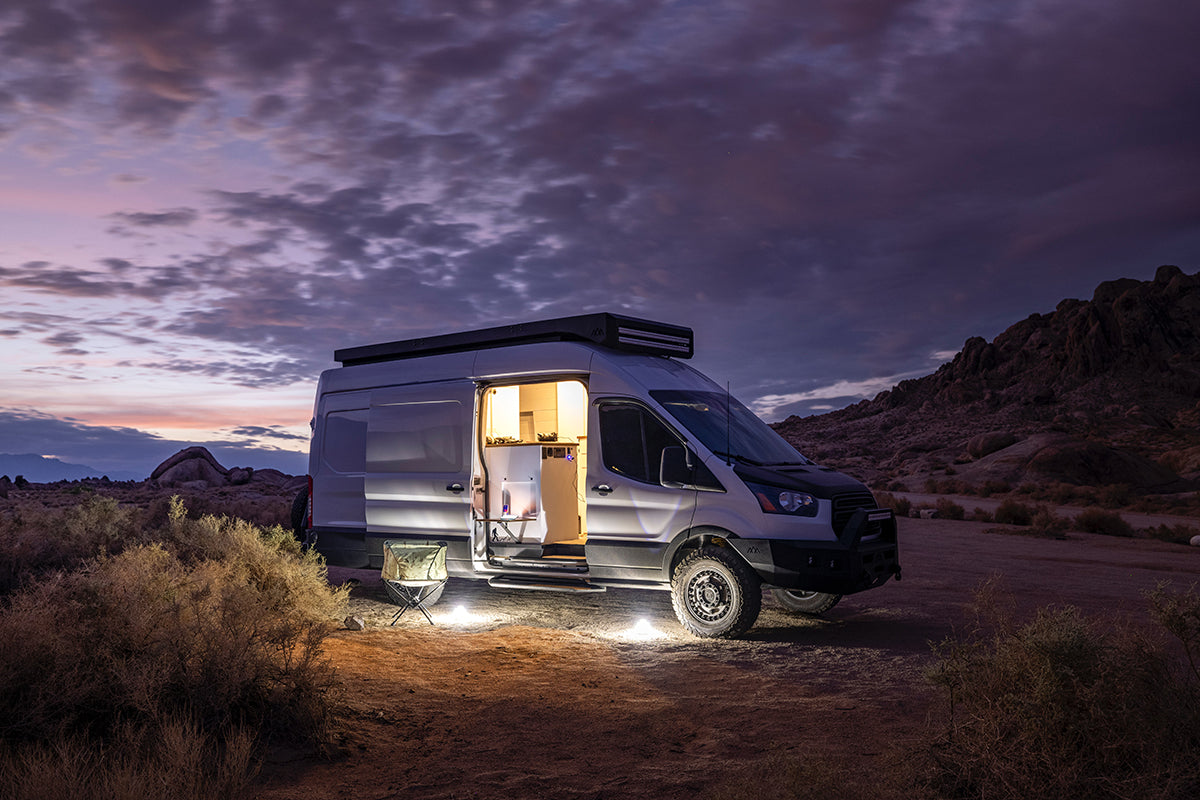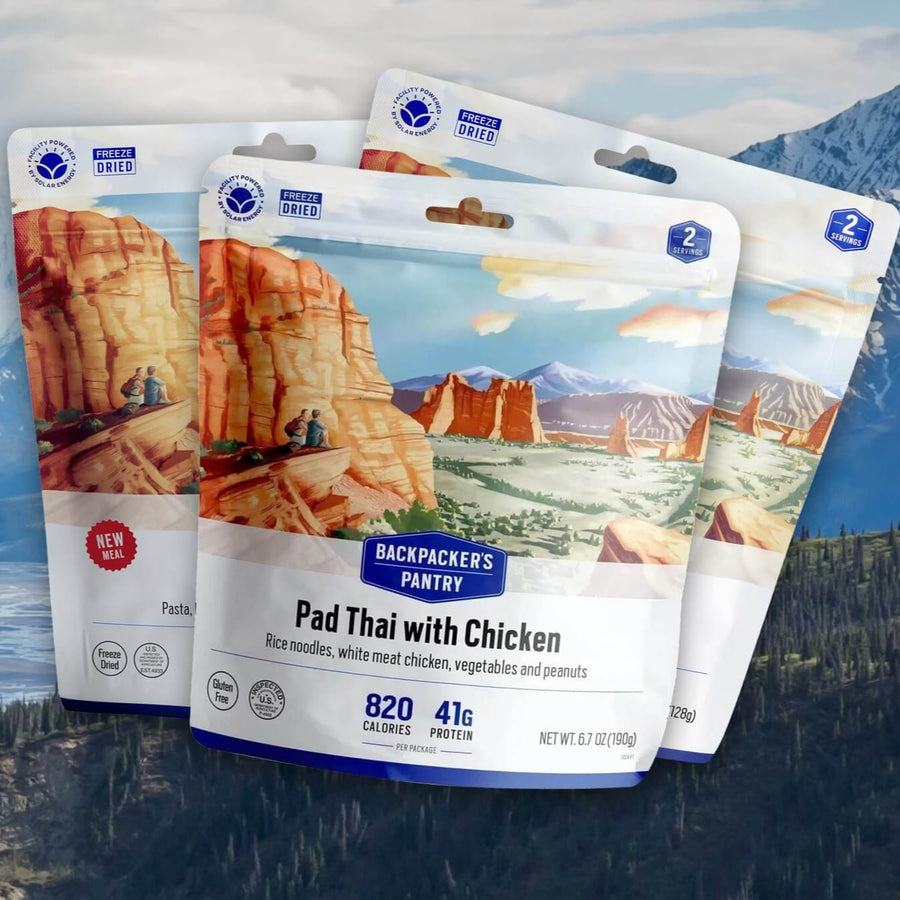Van Life Meals: How To Eat Better On The Road

Anyone who’s actually lived on the road for any serious amount of time understands that van life is complex and nuanced. Sure, it can be just as beautiful and fulfilling, and free as those trending posts on social media. But, in order to attain, and maintain that aspirational lifestyle sustainably, it takes a lot of planning and creativity. The number one question vanlifers get is probably “ where do you poop!?!” but, the question that follows soon after is, “how do you cook!?”
Cooking setups vary from van to van. Some folks have full kitchens with stoves, ovens, and microwaves built into their rigs. Others eat out a lot and occasionally boil water for oatmeal or ramen. Most fall somewhere in between, with some sort of stove or grill, and a few pots and pans that make basic cooking possible. But the challenge of vanlife nutrition remains, no matter what your kitchen setup looks like. The whole point of residing in your vehicle is casting off the typical trappings of society, and one of those trappings is conveniently located grocery stores. There’s no running a few blocks to grab that ingredient you forgot when you’re camped out deep in the desert. So vanlife cooking comes with a dual challenge, first, procuring and storing food, and second, preparing it. Luckily, we’ve got some tips for both.
Don’t just shop like you used to!
This might seem basic, but you shouldn’t use the same grocery list and schedule you did while living in a house. It just won’t work out that well for you. Instead, think creatively, budget how long it will be until you have a chance to shop again, how many meals you’re planning on eating in that time, and how long ingredients will take to spoil. Then shop away, with a focus on versatile, robust ingredients. Root vegetables, like carrots, onions, and potatoes are always a safe bet. Ingredients like tomatoes and lettuce, that will spoil quickly are fine, but you need to have a plan to cook and eat them soon, before they have a chance to turn.
Plan to consume most of your fresh fruits and vegetables within a couple days of shopping. But supplement your haul with more hearty options. Sugar snap peas stay better longer than arugula, and will help cure your craving for something green and fresh tasting.
Think about the Van Life Food Groups.
When you’re cooking on the road, it’s a good idea to diversify your food groups. And we don’t just mean making sure to eat your vegetables. Instead, we break down our “van life food groups” in terms of how much prep and energy they will require. For example, eating out requires zero prep, and zero cleanup, but is expensive and you can’t do it if you’re camping off-grid. On the opposite end of the spectrum, creating a multi-course meal from scratch, in your van, is more affordable, but requires more time and energy.
So, there’s an entire spectrum of meal types, and it’s important to have a solid mix that accommodates your lifestyle and finances. So eating out once in a while is fine, but try to aim for meals that will leave you with leftovers that you can repurpose. And then plan for several different options that require very little prep for days you’re busy or frazzled and can’t really cook. These are the five-minute meal options, like a freeze dried dinner, ramen, or mac and cheese.
Meeting in the middle, the bulk of your meals will probably be slightly more in-depth options that require 15 minutes to half an hour to prepare. Spaghetti, rice dishes, soups, tacos, etc. These are great staple meals for days when you’ve got plenty of time to cook, and clean up after yourself.
For most people, it’s not practical to cook a meal from scratch every night, but living off of instant food isn’t super healthy, or good for your mental state. So finding a balance and a compromise in your meal types is vital to happiness on the road.

Supplement instead of creating from scratch.
In addition to shopping with an eye toward expiration dates, think through what you can cook, and how long it will take you. Even something simple, like sautéing onions, or baking potatoes can take a lot longer in a van kitchen, and create a lot more hassle and cleanup than it would in a traditional kitchen. Don’t buy items that you don’t want to cook in your mobile kitchen. Instead, think of meal combos that you can supplement with fresh produce easily. Cheap ramen is easily elevated with the addition of some chopped carrots, sugar snap peas, sprouts, or an egg. And none of that requires any extra prep or cooking, just the boiling water you’d use anyway.
That’s where something like our freeze dried Pad Thai really shines. Sure, it’s great on its own, but add some garnishes, and it really elevates the meal. Top it with basil, cilantro, maybe some fresh lime or peanuts, and create a meal that’s a step above.
Always carry backup.
The magic of van life is that you can be spontaneous, changing plans in an instant to react to new opportunities. But this agility is compromised when you need to be on a strict shopping schedule otherwise you’ll run out of food. So always carry a backup. This is where something like our emergency meal kits really shine. These kits take up very little space, won’t go bad, and are easy to pack away, just in case. Then, when you decide to spend an extra day in the mountains, or you break down and need to wait for help, you’ve always got something easy to prepare, and delicious to keep you going. An emergency meal kit, combined with some essentials, like canned vegetables, some dry pasta noodles, and extra water is a great insurance policy for any adventure.

Shop for versatility, not specific needs.
When you go grocery shopping, do you look up a recipe, and shop for those specific ingredients, planning to make just that meal? That’s a pretty common way to shop, but when you’re dealing with less space in a van, it makes more sense to shop for ingredients that can be versatile and work with many meals. Don’t buy fresh cilantro for that one taco night, instead, figure out a few meals or snacks that could use cilantro, and plan them out. The same goes for many other smaller, specialty ingredients. Purchasing small quantities of them to use in just a meal or two doesn’t make sense when you’re living on the road, so it’s a good idea to have two or three meals in mind for every ingredient you shop for.
Think about what you want, not about what you’re used to.
This is truly the biggest key to cooking and eating well on the road. Think about your specific needs and preferences. How much prep time and cleanup are you alright with? How much food do you need to eat each day? How much variety are you looking for? What are your cooking capabilities? And then structure your planning around that. Some folks will need an extra big fridge for all the fruits and vegetables they want to eat. Others will need some sort of dishwashing setup since they like to prepare complex meals. Others just need a simple stove, salt, pepper, and hot sauce to make basic ingredients appeal to them. No matter where you fall on this spectrum, focus on your priorities, not what you’ve gotten used to in regular life, or what you see other folks doing.
Eating well on the road is a deeply personal decision, so think about it in that context, glean ideas and recipes from others, but ultimately, aim to craft something perfect for yourself.

Some of the best van life meals:
- Overnight oats: This is a simple and healthy breakfast option. Mix oats, milk or yogurt, and toppings of your choice in a jar, and store it in the fridge overnight. In the morning, you'll have a delicious and filling breakfast ready to go.
- Sandwiches: Sandwiches are a great option for lunch on the go. You can use any type of bread, and fill it with your favorite meats, cheese, vegetables, and spreads. They are easy to make, and you can eat them while driving or at a rest stop.
- Burritos: Burritos are a great option for dinner, and they can be customized to your liking. You can fill them with rice, beans, cheese, vegetables, and meat, and wrap them in foil for easy storage.
- One-pot meals: One-pot meals are easy to make and require minimal cleanup. You can make a variety of dishes, such as pasta, rice, or soup, and store the leftovers in the fridge for later. Backpacker's Pantry meals are a great choice here.
- Grilled foods: If you have a portable grill, you can make a variety of meals, such as burgers, hot dogs, or kebabs. Grilled food is delicious and can be enjoyed while camping or at a rest stop. Plus, grilling can cut down on dirty dishes.
- Snacks: It's important to have snacks on hand for when you get hungry on the road. Some great options include trail mix, fruit, energy bars, and beef jerky.
- Tacos: Tacos are a versatile and easy meal that can be customized to your liking. You can use any type of protein, such as chicken, beef, or tofu, and add toppings like cheese, lettuce, and salsa. They are easy to make and can be eaten on the go.
- Veggie bowls: Veggie bowls are a healthy and filling meal option that can be made with a variety of ingredients. You can use grains like quinoa or brown rice, and add roasted vegetables, beans, and a flavorful sauce for added flavor.
- Frittatas: Frittatas are an easy and tasty breakfast or lunch option. They are easy to make in a cast-iron skillet, and you can add any vegetables or meats that you have on hand. They also make great leftovers for a quick meal the next day.
- Grilled cheese: Grilled cheese is a classic comfort food that can be made with just a few ingredients. You can use any type of bread and cheese that you like, and cook it up in a skillet or on a griddle. It's a simple meal that is perfect for a rainy day in the van.





